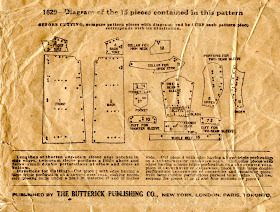The design of the crossed collar which buttons into the waist belt is odd, particularly in a hue darker than the dress itself, but the sailor's collar is very common at this period, and is a first cousin to the collars found on middy blouses, commonly worn at this period for casual, sporting, or athletic use.
Outside of the peculiar collar, this is a nice design. The button front means that the dress can be opened out for ironing. The tucks on either side of the front and on the back add some practical fulness as well as provide an attractive vertical line.
At this time, Butterick's instruction sheet, hasn't yet been titled "The Deltor," though Butterick has applied for a patent for it.
By 1921, Butterick was advertising the advantages of The Deltor with a full page advertisement in the February 1921 issue of Everybody's Magazine:














